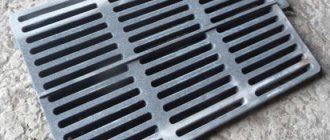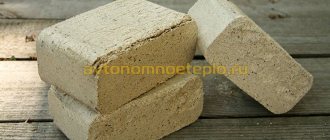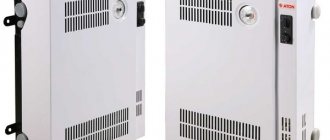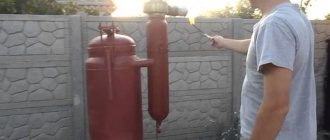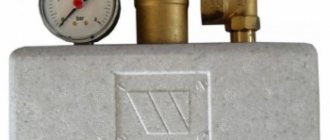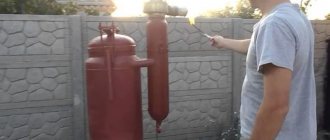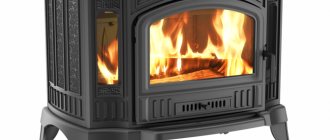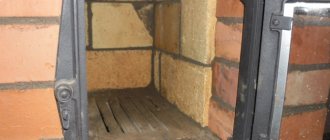Despite their simplicity and simplicity, cast iron grates for a stove or boiler perform several functions, each of which is very important (see Stove heating in a wooden house). Usually the grille lasts no less than the heater itself, but there are force majeure situations when replacement is required. As you know, cast iron is quite fragile and can be cracked even if dropped onto a hard surface from a height of one meter. That is, just accidentally letting go of it while standing at full height. You can find standard grate bars in the retail chain, and if they don’t fit, it’s easy to make them yourself.
Why is it needed?
As has already become clear, the grate is a grate that allows the air flow to penetrate directly to the combustion center below, and the ash to be removed through the holes to a specially designated place for it. So why do we need grates in a furnace? Installing a grate in a furnace allows you to solve a number of problems:
- Divides the combustion chamber into two zones - the combustion chamber itself and a niche for ash.
- Used for placing and drying fuel.
- Distributes the air flow from the ash pan.
- Promotes good traction.
- Together with the door it makes it possible to control and regulate the flame.
The grate, which is intended for installation in the stove, cannot be made from any metal. Since it is constantly exposed to high temperatures and oxygen, it can begin to oxidize very quickly. Only cast iron can survive in this environment for a long time
Grate materials and configurations
To make grates for a furnace or boiler, cast iron or heat-resistant steel is used. The first option is preferable and is used most often, since cast iron lasts almost forever. Steel, even strong steel, can burn out over time, especially if heated with coal. As is known, the combustion temperature of coal is the highest among all types of solid fuel.
The lattice can have the form:
- flat plate;
- interconnected round or profile beams;
- metal basket.
In addition, grates can be monolithic or stacked. Monolithic is a solid product of a certain size. Sometimes standard dimensions are not suitable and then they use stacked grates for a fireplace or stove, in which the main thing is to choose the length of the elements.
If you are going to install a heated floor under linoleum on a wooden floor, then only an electric one.
While it is better to make a warm floor under tiles from plastic pipes (water TP).
The grate can be movable. Such products consist of several parts that are driven manually using a special lever. There are two options for movements: translational and rotational. Thanks to the movable grate, it is possible to supply air to the stale layers of fuel, which allows you to completely burn it out. This increases the efficiency of heating equipment by several percent.
Design features and types
The grate is a grate with separate elements that perform the function of maintaining fuel in the combustion chamber. Based on the design, it is customary to distinguish the following types:
- Flat tile grate. This grate for the furnace is the most common. It is also used in boilers and fireplaces. Its difference lies in certain dimensions. This nuance must be taken into account when laying the stove manually. An installation platform is required for installation into a heating device. It should be easy to remove and the gap should be at least 50mm. After all, almost all grates are made of cast iron, and when expanded, it can cause harm to the combustion chamber and ash pan.
- Beam lattice. This cast iron grate for the stove is stackable. The number of elements must correspond to the dimensions of the firebox. The beam option is the best for arranging a non-standard handmade stove. However, it is necessary to remember about the standards for its length.
Beam grate for oven
- Basket-shaped. Such grates can be used in open fireboxes. Recently, they are installed quite rarely, because a heating device of this type has lost its relevance.
Basket-shaped grate
- Movable grid. The main function in this case is to limit the size of the gap between the grates through the shift of the moving part in the horizontal plane. This is quite convenient for the automatic operation of long-burning stoves.
Movable grate design
Boiler grates
Boiler grates
Boiler grates are flat cast iron castings with holes installed in the furnaces of solid fuel steam and hot water boilers.
Application of grate bars
Cast-iron boiler grates are installed in boilers on the ledges of the side walls of the furnace part of the boiler. Cast iron boiler grates are a flat plate with stiffening ribs and longitudinal holes designed to supply oxygen-rich air to the lower layers of burning fuel and remove ash and slag formed during the combustion process.
The power of hot water boilers in which cast iron grates are installed is up to 2.5 MW. Boiler brands KVR, KV, Energy, Universal, Siberia, Luga, NR-18, Bogatyr, KV-300, Hephaestus, KVTs.
Grate sizes
Boiler grates are presented in a wide range of sizes from 200 to 1500 mm in length and from 100 to 300 mm in width. The most common grate models are 880x220, 890x250, 906x250, 560x250, 530x250, 520x210, 520x220. The dimensions of the grate are determined by the convenience of their installation in the boiler firebox; usually 4-12 pieces are installed along the entire perimeter of the firebox.
The weight of the grate varies depending on its thickness, the diameter of the holes and the number of stiffeners.
Operation of grate bars
The service life and reliability of cast iron grates and grates depend on the correct operation of the boiler. Coal must be loaded into the boiler furnace onto the grate in an even layer, no more than 200 - 300 mm thick; periodic skimming of the fuel layer and cleaning of the grates from slag deposits and build-ups is mandatory. The air supply to the boiler must be constant and continuous to ensure stable combustion and air cooling of the grates. The ash bin must be cleaned of failed ash and slag regularly and often enough to avoid their residual combustion in the ash bin and an increase in the temperature at the bottom of the grate. If you follow these simple rules, the boiler grates will last you 4-5 heating seasons.
Grate material
The material used for the manufacture of grates is cast iron. The grate supports a layer of burning fuel, the temperature of intense combustion of which can reach or even exceed 1000 °C. The constant flow of oxygen aggravates the oxidative processes on the surface of the metal from which the grate is made. No other material, even heat-resistant steel of average cost with a temperature of the onset of scaling of about 750 ° C, not to mention sheet black steel, will withstand long-term operation in such conditions.
Boiler plant Energia M produces grates of the widest model range, as well as cast iron grate boilers according to customer drawings.
To buy boiler grates, use the services of our online store or call 8-800-700-15-79.
Dimensions of grate for the furnace
The dimensions of cast iron grates for a furnace depend on the type of fuel. Their possible sizes are presented in the table.
| Firewood | Coal |
| 330*252 mm | 350*205 mm |
| 300*252 mm | 300*205 mm |
| 250*252 mm | |
| 250*180 mm | |
| 140*180 mm | |
| 120*140 mm |
If it is necessary to install beam gratings, you need to remember that the length is 250, 330 and 470 mm.
Iron foundry shop
One of our main advantages and methods of work is to meet halfway needs of our regular and potential clients! An individual approach to each customer allows us to find the most effective cooperation schemes. We offer all clients the most favorable conditions for purchasing cast iron castings and a flexible system of discounts. It is profitable to cooperate with us!
Manufactured products undergo strict quality control, are certified and comply with GOST and TU.
The shipping department will select for you the optimal conditions for delivering castings directly to your warehouse. Also, the delivery cost itself can be included in the cost of the product at your request.
We present to your attention the following types of products made of gray cast iron, grades SCh10..SCh20 GOST 1412-85:
- sewer cast iron hatches (type L, S, T, GTS);
- cast iron storm water inlets (type D, DB, DK, DM);
- storm drainage gratings in an assortment;
- cast iron grates and grates for heating boilers and furnaces;
- sections and plates of cast iron boilers Universal -5, -6, KChv, BKMZ, KChM and others;
- cast iron tiles (square and hexagonal) for the floor;
- stove casting (grid-irons, fire doors, country stoves, stoves);
- decorative castings (fences, memorial plaques, benches, lawn fencing, pillars, urns, etc.)
Casting of spare parts, components for agricultural machinery, mechanical engineering, machine tool industry, automobile and tractor spare parts:
- pulleys, flywheels, gears, sprockets, pump housings, gearboxes, bearing housings, covers;
- parts of grain throwers, grain loaders, seeders, winnowers, conveyors;
- counterweights for lifting equipment, cranes, elevators;
- pallets, slabs, shoes.
Castings for rolling freight and passenger trains:
- slabs for arranging tram and railway crossings;
- cast iron weights for tensioning conductors.
Castings for track services of sea and river shipping companies, ship repair and shipbuilding plants: cast iron ballast in sea ingots.
We offer our clients high-quality castings from gray cast iron to order: all kinds of castings of various geometric shapes and sizes for further machining.
We carry out development, design and production of model equipment. It is possible to work according to your model equipment.
You can make a request to manufacture or purchase products directly on our website.
We will be glad to see you among our clients!
Recommendations for selection
When choosing a specific model, you should take into account the type of fuel that you plan to use. Take note of the size chart above. The grate must be taken in such a way that the rods can easily support the maximum possible weight of one fuel portion. This information can be clarified with a store consultant or specialist.
To clear ash, it is better that the gaps occupy at least 40% of the area of the entire structure. If there are fewer of them, the combustion chamber will not function as efficiently, because the volume of incoming air will be small for good combustion. If ventilation is poor, gases may accumulate. In the case of large gaps, fuel that has not had time to burn out will fall into the gaps along with the ash.
What functions do grate bars perform?
The grate is a grate in the firebox of a boiler, stove or fireplace, which is built into the lower part. It performs three functions:
- solid fuel retention;
- air supply;
- ash removal.
Firewood, briquettes or coal are placed on the grates. Depending on the type of fuel, it is necessary to select the gaps between parallel elements. The grate must be strong enough to support the weight of the wood. In addition, the grate for the boiler allows air to be supplied for combustion. In this case, you can regulate the amount of air, thereby controlling the traction force. There is a special compartment under the grate where ash falls. It is closed by a door or flap. Through the door you can not only remove ash, but also regulate the air supply.
